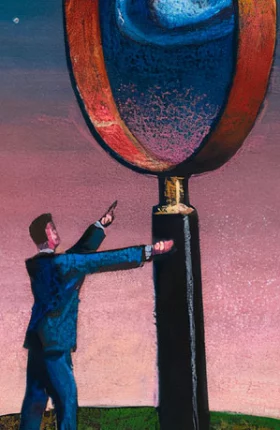In Thoroughbred racing, only a few pull out ahead and finish in the money; the rest run with the pack. There are winners, and there are also-rans.
It’s the same in business. There can only be one biggest or best. A few others might give the leader a run for its money. The rest are left behind.
The Boston Consulting Group has been helping companies outrun the competition for 50 years. One thing we have stressed throughout our history is that there are no permanent victories. You have to run your heart out every day.
Consider the following statistics. Of the top 100 U.S. companies in terms of annual revenues in 1963, the year BCG was founded, more than 40 percent were gone from the Fortune 100 list 25 years later. Some had collapsed in bankruptcy. Some had been subsumed through mergers and acquisitions. Others had been broken up. And others, failing to keep pace, slipped or fell behind. Today, even more of 1963’s Fortune 100 are gone. And nearly two dozen companies are on the list that didn’t even exist in 1963.
The trend continues. Of the 100 top-grossing companies on Fortune’s Global 500 list in 2005, for example, 11 were no longer among the top 100 by 2012. Or consider Asia's Fab 50, which Forbes has published since 2005. The companies are ranked by market value and must be less than 50 percent state owned to be included. Of the original Fab 50 from 2005, only five were still on the list last year.
All this points to another lesson we’ve stressed during our half-century of business: if you want to own the future, you have to start now.
So, if the game is changing, what are the new rules? Enumerating them is the purpose of our new book, Own the Future: 50 Ways to Win from The Boston Consulting Group .
The book’s core message is that today’s leaders need to up their game if they aspire to pull away from the pack. In the face of an environment of accelerating change—of what some are calling the most radical restructuring of the global economy since the Industrial Revolution—bold transformational moves may make more sense than incremental fine-tuning. Based on BCG's 50 years of practice, the book enumerates 50 ideas that we feel will empower upstarts and inspire leaders to new heights—and it lays out ten characteristics critical to an organization's success today.
So what qualities characterize the organizations that will be among the top five, 10 and 25 years from now? Businesses—as well as many nonprofits and governmental agencies—need to be:
- Adaptable. With the business environment more unsettled than ever before, adaptiveness becomes an essential driver of competitive advantage. Tomorrow’s winners will be those best at identifying and anticipating market shifts; experimenting rapidly, frequently, and economically; managing complex, multicompany systems; and fluidly mobilizing people and organizational resources. Shorter cycles and faster reaction times will be essential—time-based competition is back, but the focus has expanded to include insight and learning.
- Global. As my colleagues Hal Sirkin, Jim Hemerling, and Arindam Bhattacharya argued in their 2008 book, Globality, companies today are competing with everybody from everywhere for everything: markets, talent, financing, energy, raw materials—you name it. But with challenges come opportunities. The growth markets of the future—China, India, Southeast Asia, Latin America, and Africa—take many leaders out of their comfort zone. What works in Munich is unlikely to work in Mumbai. Moreover, Western executives who think they’ve gained an understanding of the fluid global marketplace after they’ve spent a few days in Beijing, New Delhi, or Brasilia need to dig deeper. Over 700 cities in emerging markets have populations exceeding 500,000; most of them are growing fast. The opportunities in these markets are as unbounded as the optimism of the consumers who inhabit them.
- Connected. It’s been nearly 50 years since the song “It’s a Small World” was unveiled at the 1964 World’s Fair. Since then, the world has only gotten smaller thanks to faster transport, faster finance, and the explosion of digital connectivity driven by the plummeting costs of both computing and communications. These changes have profound strategic implications that today’s leaders must embrace. Connectivity has the potential to be both a huge force multiplier and a huge disruptor. It enables new ways to connect with customers, suppliers, and partners. It engenders new customer behaviors. It makes possible new business models with radically different economics. It cannot be ignored.
- Sustainable. Continued growth of the global population and of emerging economies is pushing business and political leaders to find ways to make more efficient use of limited natural resources. Along the way, many businesses have found that this leads not only to a better society but also to a better bottom line because sustainability-related business-model innovation can produce cost savings, revenue growth, and competitive advantage. And that enhanced competitive advantage makes an organization’s leadership position more sustainable as well.
- Customer First. Great companies aim to create deep and lasting emotional bonds with their customers. At the very least, they transform their customers into repeat buyers and, in some cases, brand evangelists. Pulling this off requires a multilayered understanding of customers’ hopes, dreams, and concerns. It demands understanding the compromises that competitors are imposing on customers—and devising innovative ways to break those compromises. The best companies never leave the thinking about customers and brands solely to their marketing departments.
- Fit to Win. Execution is a core driver of sustainable competitive advantage. But great companies take a strategic approach to operations. They focus on driving improvement in the areas most critical to success. They have flat, agile organizations that speed up information flows, improve decision making, and lift morale. They have demand-driven supply chains. They deploy sophisticated approaches to pricing. And they have the IT capabilities needed to support and accelerate their strategies. Like marathon runners, they are “fit to win.”
- Value-Driven. Certain principles of management and leadership are timeless and enduring. One of these is as old as commerce itself: the mandate to create value. Organizations that don’t, don’t last. Value, of course, has two components: earnings and growth. One without the other is inadequate. The value they create together sets the stage for future growth by attracting talent and capital. But at a time when the life cycles of business models are shortening, executives need to take a much more strategic and agile approach to investment decisions to ensure both short-term value creation and long-term success.
- Trusted. Trust doesn’t appear on the balance sheet. Nonetheless, it’s a company’s most valuable asset: the hardest to build and the easiest to squander. Long-term success is impossible without trust. Trust is the glue that binds coworkers together, turns supply chain participants into business partners, and allows widely dispersed networks of individuals with disparate interests to collaborate as teammates on the greatest innovations of our time. And the digital revolution—because of greater connectivity and lower transaction costs—offers unprecedented opportunities to accelerate and expand the process of reputation building.
- Bold. As we noted earlier, the industry landscape is littered with companies that didn’t evolve with the times. Incremental changes are often too little, too late. Forward-looking companies continually reinvent their business models through ongoing experimentation and innovation. Consequently, they are far less likely to be blindsided by changing markets and maverick competitors. But maintaining a culture of continual reinvention requires bold leadership. It takes courage: the ability to challenge teams to stretch their thinking, the willingness to encourage experimentation and tolerate failure in the service of learning and future success.
- Inspiring. Today’s most successful leaders do not bark orders; they create the conditions that allow their teams to succeed. They aim to inspire, not instruct. Former BCG CEO John Clarkeson anticipated this change in 1990 when he wrote “Jazz vs. Symphony,” arguing that tomorrow’s winning companies would be agile and quick, operating “more like a collection of jazz ensembles than a symphony orchestra.” Leadership is more about asking the right questions than knowing the answers. More about sharing authority and setting clear boundaries than planning elaborate campaigns up front. More about inspiring the organization to do the right thing.
Building these characteristics into your organization’s DNA doesn’t guarantee success—but it will significantly improve your odds. Business, like horse racing, is a mixture of genetics, circumstance, and training. You can’t do much about the first two, but you can prepare your organization to face change with skill, wisdom, and daring. You can build the capabilities needed for foresight and experimentation. You can empower your teams and foster greater agility in your organization. You can work to shape developments in your industry in your favor. And with luck, you can change the game and own the future.









